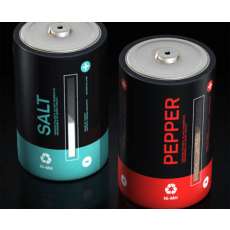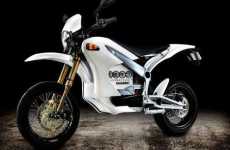
Jeremy Gutsche — June 3, 2007 — Autos
References: latimes & treehugger
Lightning Motors in California has converted a Yamaha R1 into a lithium-powered superbike. The bike handles like a Yamaha R1, but the entire engine has been removed to make room for the batteries. Now, it rockets silently to 100 mph.
The cost of the conversion was around $15,000, but Lightning Motors expects they can reduce the cost to the $6k - $8k range.
The bike was just featured in the LA Times, who compared the ride to the Tesla supercar, "Unlike the Tesla electric sport car, which is powered by thousands of tiny batteries, the R1 conversion uses just 28. Each of them is 90 amp-hours at 3.2 volts and 6.6 pounds. Together, they weigh less than everything that was taken off the bike to make it electric. While the majority of the batteries are concentrated in a Mondrian-esque block where the engine used to be, they're also tucked under the seat where the exhaust was once located, to mimic the weight distribution of a stock R1."
Details:
Lightning Motors' 1999 Yamaha R1 electric conversion
Price: $15,000
Powertrain: AC regenerative motor powered by lithium iron phosphate batteries, 550-amp system, one speed
Maximum torque: 80 pound-feet
Maximum rpm: 8,000
Potential horsepower: 70
Estimated range: 80 miles at 65 mph
Dry weight: About 400 pounds
Charge time: Seven hours with on-board charger that plugs into a standard outlet
The cost of the conversion was around $15,000, but Lightning Motors expects they can reduce the cost to the $6k - $8k range.
The bike was just featured in the LA Times, who compared the ride to the Tesla supercar, "Unlike the Tesla electric sport car, which is powered by thousands of tiny batteries, the R1 conversion uses just 28. Each of them is 90 amp-hours at 3.2 volts and 6.6 pounds. Together, they weigh less than everything that was taken off the bike to make it electric. While the majority of the batteries are concentrated in a Mondrian-esque block where the engine used to be, they're also tucked under the seat where the exhaust was once located, to mimic the weight distribution of a stock R1."
Details:
Lightning Motors' 1999 Yamaha R1 electric conversion
Price: $15,000
Powertrain: AC regenerative motor powered by lithium iron phosphate batteries, 550-amp system, one speed
Maximum torque: 80 pound-feet
Maximum rpm: 8,000
Potential horsepower: 70
Estimated range: 80 miles at 65 mph
Dry weight: About 400 pounds
Charge time: Seven hours with on-board charger that plugs into a standard outlet
Trend Themes
1. Lithium Battery-powered Motorcycles - The conversion of traditional gas-powered motorcycles to lithium battery-powered ones can disrupt the motorcycle industry and provide opportunities for companies to create cleaner and more sustainable transportation options.
2. Lightweight Lithium Batteries - The use of lightweight lithium batteries in other vehicles, such as cars and trucks, can increase fuel efficiency and provide a more eco-friendly alternative to traditional gas-powered vehicles.
3. Electric Vehicle Conversion Kits - The development of conversion kits for gas-powered vehicles that allow for the integration of electric vehicle technology can disrupt the automotive industry and create opportunities for sustainable transportation solutions.
Industry Implications
1. Motorcycle Manufacturing - Motorcycle manufacturers can capitalize on the trend of converting gas-powered motorcycles to lithium battery-powered ones by creating and selling their own electric models.
2. Battery Manufacturing - The development of lightweight and efficient lithium batteries can create opportunities for companies in the battery manufacturing industry to provide solutions for electric vehicles and other applications.
3. Automotive Conversion Services - Businesses that offer automotive conversion services can take advantage of the demand for electric vehicle conversion kits, providing a more eco-friendly alternative to traditional gas-powered vehicles.
6.2
Score
Popularity
Activity
Freshness























